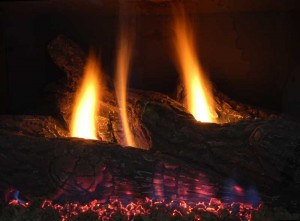Three different types of gas fireplaces are available, depending on intended use and budget considerations. These are decorative gas logs, vent-free or ventless fireplaces, and the vented variety. Regardless of which the homeowner chooses, all of these gas fireplaces are clean, efficient, and economical appliances.

If the ambience created by a fireplace is more important than the heat it contributes to the house, gas logs may be the best choice. Installed in a wood burning fireplace with a chimney in good condition, their heat is drawn up it and out of the house. The damper must remain open and heat is generated only in the room where the fireplace is located.
Vent-free gas fireplaces are probably the best option for homeowners with a limited budget who live in states that do not prohibit their use. Extremely efficient, almost all of the heat they generate stays in the house and they produce very little carbon monoxide. One drawback with these systems is the addition of moisture and flue gases to the house, occurring naturally as a by-product of combustion.
The third type of gas fireplace to be considered is a vented fireplace, which also requires a chimney pipe. They can be vented either at the top or the rear, and are often equipped with a blower. Rear venting of a direct vent fireplace is more efficient because heat remains in the firebox longer.
Direct vent fireplaces use double walled chimney piping to draw fresh air in and heated air out. The inner pipe channels air from the fireplace out of the house while the outer one allows fresh air in. This configuration also permits the hot inner pipe to be cooled by the air it admits from outdoors and reduces the clearance needed between the chimney and flammable materials to prevent a house fire.
Remember, even with gas fireplaces, regular inspections are highly recommended.
